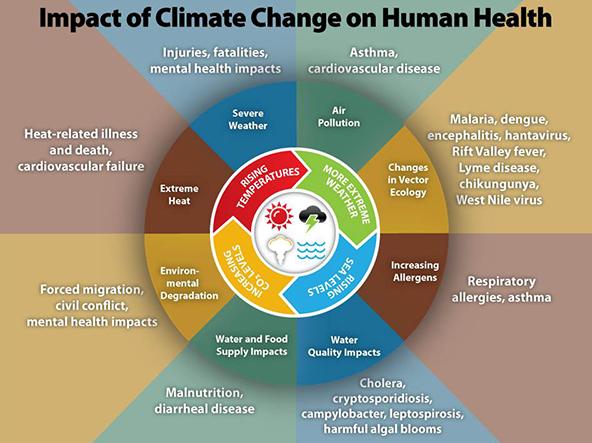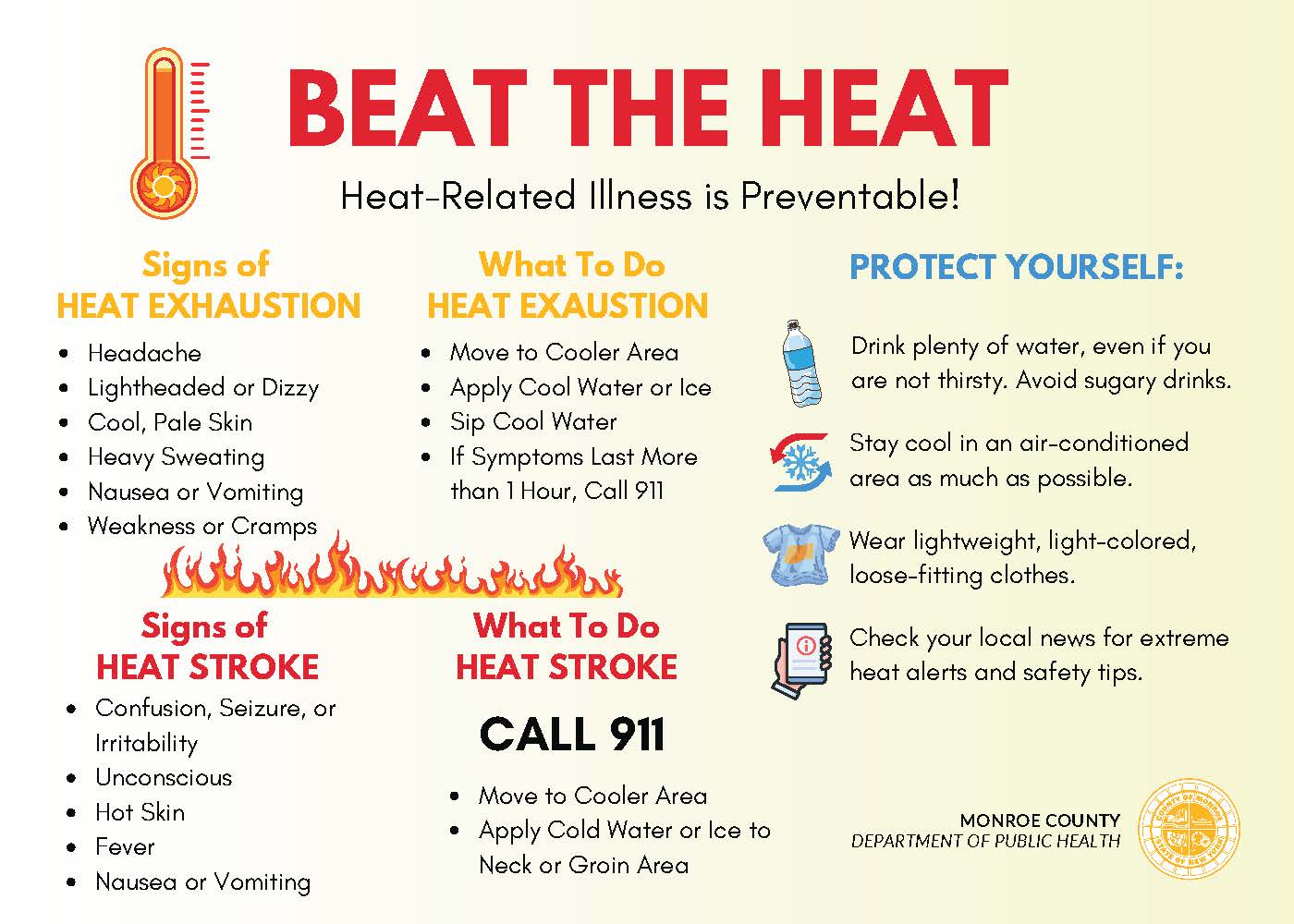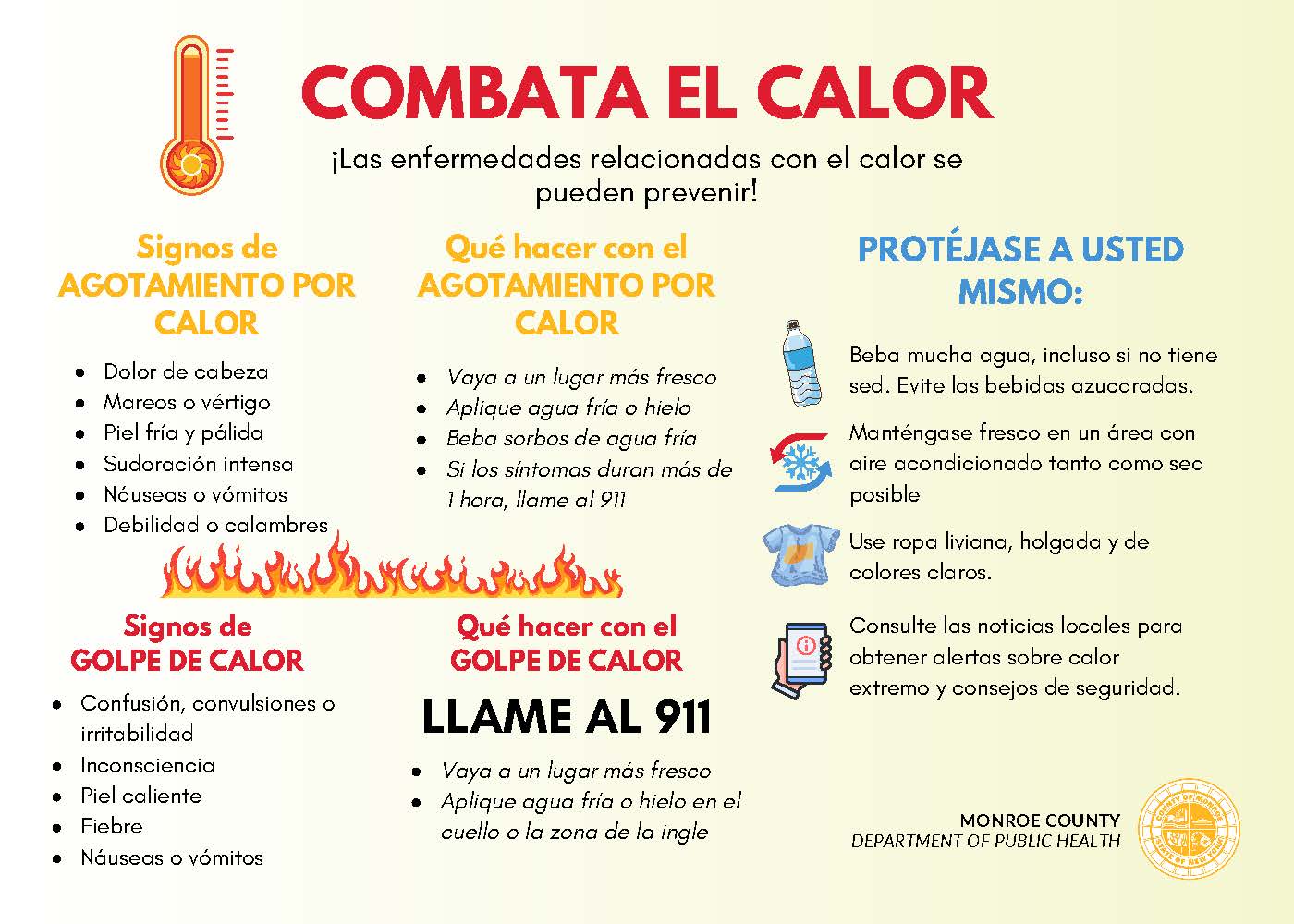New York State Heat Risk and Illness Dashboard
Monroe County Climate Action Plan
Climate Change, Extreme Weather, and Health in Monroe County
Climate change is happening when there are significant changes in weather patterns— such as temperature, precipitation and wind patterns — that occur over years, decades, and centuries. While climate change is a global problem it can affect people and places differently. Climate change is affecting the health of residents in Monroe County, NY. This webpage provides an overview of key climate-related health risks and connects you to trusted resources from New York State agencies. Learn how you can protect yourself and your loved ones.
The most severe harm from climate change fall disproportionately upon underserved communities who are least able to prepare for, and recover from, heat waves, poor air quality, flooding, and other impacts.

Source: Centers for Disease Control and Prevention, Climate and Health Program
How Climate Affects Health
The scientific understanding of climate change is evolving. We know that changes in climate affect health in many ways. For example, droughts and severe floods can affect drinking water quality, food safety, and air quality which can increase risks of illness and injury. Extreme heat and extreme cold increase the risk of serious health problems, including heat stroke or hypothermia, and can worsen chronic conditions such as asthma, heart disease, and diabetes.
Climate change also increases the risk of infectious diseases transmitted by ticks and mosquitos, such as Lyme disease or West Nile Virus. These diseases can spread where changes in temperature and rainfall provide better breeding conditions for ticks and mosquitos.
☀️ Extreme Heat
About Extreme Heat
Extreme heat is defined as summertime temperatures that are much hotter and/or humid than average. Heat-related illnesses, like heat exhaustion or heat stroke, happen when the body is not able to properly cool itself.
Información acerca del calor extremo
El calor extremo se define como temperaturas de verano mucho más altas o condiciones mucho más húmedas de las promedio. Las enfermedades relacionadas con el calor, como el agotamiento por calor o el golpe de calor, suceden cuando el cuerpo no tiene la capacidad para enfriarse adecuadamente.
Heat edema -feet or hands swell when a person sits or stands for a long time in a hot environment, commonly individuals not accustomed to heat
Heat syncope - fainting episode that someone can experience in high environmental temperatures, usually during the initial days of heat exposure; commonly individuals not accustomed to heat
Sunburn - inflamed, painful skin that feels hot to the touch and often appears within a few hours of being in the sun too long, sometimes blisters
- Moderate: Heat exhaustion – extreme fatigue, weakness, headache, dizziness, nausea, vomiting.
- Severe: Heat stroke – older individuals with underlying health problems, extreme exercise, outdoor workers.
Indoor heat safety:
Follow these tips to help lower your risk of suffering from heat illness while indoors:
- Use your air conditioner if you have one. Fans alone will not provide enough cooling when it is very hot outside.
- Set your air conditioning unit to 78° or “low cool” to be safe, comfortable and save money. Just a few hours in a cool place can make a difference.
- Close window shades or curtains.
- Try not to use your stove and oven.
- Take a cool shower or bath.
- Drink plenty of water, even if you are not thirsty.
- Avoid drinks with alcohol, caffeine or lots of sugar.
Find out if your household is eligible to receive a Home Energy Assistance Program (HEAP) Cooling Assistance Benefit for the purchase and installation of an air conditioner or a fan to help your home stay cool - HEAP Assistance
Outdoor heat safety:
Stay safe outdoors with these tips:
- Avoid strenuous physical activity.
- Drink plenty of water, even if you are not thirsty.
- Stay in the shade and out of direct sun.
- Wear light, loose-fitting clothes.
- Put a hat on to protect your face and head.
- Use sunscreen with SPF 15 or higher, every 2 hours.
- Limit outdoor activities to early morning and late evening hours.
- Avoid drinks with alcohol, caffeine or sugar.
If your work outdoors regularly, you are at higher risk for heat illness. To lower your risk:
- Drink water every 15 minutes.
- Take frequent rest breaks in shaded or air-conditioned areas.
- Wear lightweight, light colored, loose-fitting clothing if possible.
- Be alert for the signs of heat illness in yourself and in your colleagues.
*Find a cool place: Use the Cooling Center Finder Map and enter in your address to find a Cooling Center near you. Additional cooling centers may be activated during heat waves. If a cooling center is not available, air-conditioned libraries, supermarkets, and malls are great places to stay cool.
Cooling Center Finder Map - health.ny.gov/environmental/weather/cooling/
🌫️ Air Quality
Refer to Monroe County, NY - Environmental Health - Outdoor Air/Open Burning
🔥 Wildfire Smoke
Refer to Monroe County, NY - Environmental Health - Outdoor Air/Open Burning
🌊 Harmful Algal Blooms (HABs)
Health Risks from HABs
- Some blooms produce toxins that can cause skin rashes, nausea, and vomiting.
- Can harm pets and livestock.
- May contaminate drinking water.
Protect Yourself
- Avoid swimming or fishing in water with green scum or discoloration.
- Obey posted HAB warnings and closures.
- Keep pets away from suspect water.
🌾 Pollen and Allergies
Pollen is an airborne allergen that can affect our health. Pollen grains are tiny “seeds” dispersed from flowering plants, trees, grass, and weeds. The amount and type of pollen in the air depends on the season and geographic region.
Pollen-Related Health Effects
- Longer pollen seasons due to warming temperatures.
- Increased severity of allergic rhinitis - include sneezing, runny nose, and congestion.
- Allergic conjunctivitis is eye lining (conjunctiva) inflammation due to exposure to allergens like those in pollen. Symptoms from allergic conjunctivitis include red, watery, or itchy eyes.
Protect Yourself
- Monitor local pollen counts - National Allergy Map | Pollen.com
- Keep windows closed during high pollen days.
- Shower and change clothes after spending time outdoors.
🦟 Vector-Borne Diseases: Ticks & Mosquitoes
Health Risks
- Ticks can transmit Lyme disease, anaplasmosis, and babesiosis.
- Mosquitoes can transmit West Nile virus and Eastern equine encephalitis (EEE).
Protect Yourself
- Use EPA-registered insect repellent.
- Wear long sleeves and pants in grassy/wooded areas.
- Perform tick checks after outdoor activities.
- Eliminate standing water around your home to reduce mosquito breeding.
Other Resources/Otros recursos
- Rochester Community Air Monitoring Study (NYSDEC)
- Climate Smart Communities (CSC)
- Find a NYSERDA Program















